Ian Tam: The financial industry is played with a myriad of acronyms which can be a barrier for retail investors to understand fee structures. Today, we'll talk through these terms and give you an idea of where those fees go and show you where you might find those fees on a company's funds' factsheet.
First off, let's start with the ongoing fees or those fees that you pay in perpetuity for as long as you own a fund. Number one is going to be operating expenses. These are the expenses that are required for a fund to actually run. For example, the costs of record-keeping, custodial fees, regulatory filings and legal fees. The fund company itself receives this portion of fees that you pay. Number two is the management fee. The management fee is what the fund company charges for their portfolio managers to manage your portfolio. And again, the fund company receives this amount of your fees. Number three is taxes. This refers to the taxes paid by the fund company to the Government of Canada. This excludes taxes on capital gains, income and dividends that you actually pay yourself if invested outside of a tax shelter like an RRSP. Number four is trailing commissions and advice fees. This is what the fund company pays the advisor for distributing the fund to you and for providing financial advice. Your advisor receives this portion of the fees. In Canada, the popularity of fee-based advisors is rising. Fee-based advisors provide you with an F-class share of a fund, which often come with no embedded trailing commissions. Instead, you pay your advisor a flat fee each year instead of the fees on each individual fund that you own.
The sum of the four fees that I've mentioned above are referred to as the management expense ratio or MER. This amount is found on the fund factsheet which is required by law to be provided to you prior to purchasing a mutual fund.
Finally, we have what's called a trading expense ratio or TER. This is the cost of the portfolio management to place trades on your portfolio. Typically, these fees go to the market maker or the capital markets divisions of financial institutions in Canada. Your cost on an ongoing basis is the sum of the MER and the TER, both of which can be found on the fund facts document. You don't pay these fees explicitly. They're deducted from the fund performance each and every single year.
Now, let's talk about some of the one-time fees that you may be charged depending on the fund that you're interested in. Number one are front loads or initial sales charges. These are basically one-time commissions that you pay your advisor for selling you the fund. The use of front loads or initial sales charges is fairly low in Canada, but they are technically allowed. Number two are backend loads or deferred sales charges. This is a commission that is charged to you if you end up redeeming your units or selling your fund before a set number of years. Recently, our regulators have proposed the outright ban of deferred sales charges, but the proposal was struck down by the Government of Ontario and is now under further review. Number three are short-term trading charges. This is charged if you sell your fund within seven days of purchasing it. These one-time charges should appear near the end of the fund facts document.
For Morningstar, I'm Ian Tam.





















